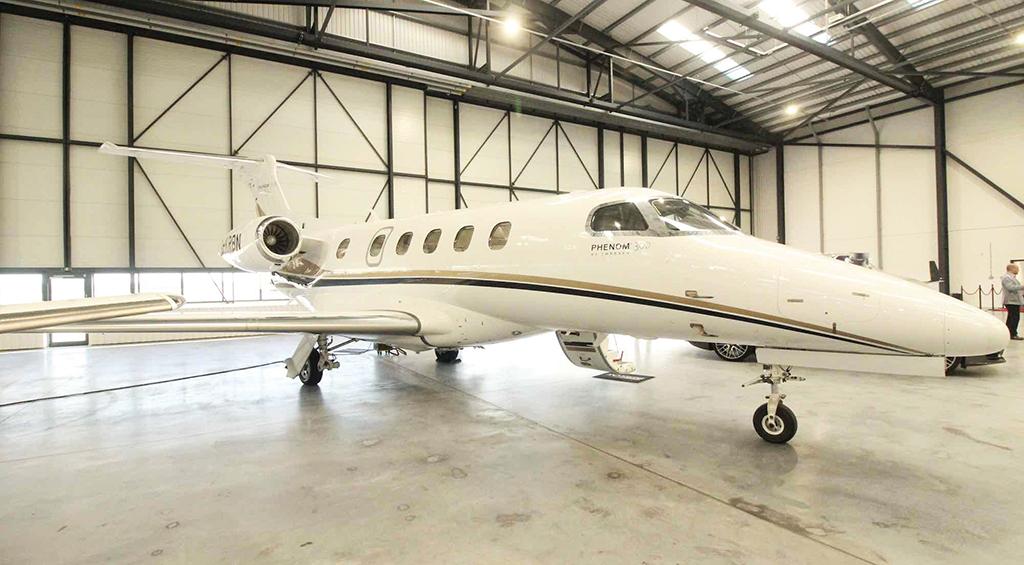
A Phenom at SaxonAir.
Business aviation boomed during the COVID-19 pandemic, but as vaccines enabled much of the world to return to something close to business as usual, the private air charter world has had to adapt to a new set of operational norms. This has brought challenges for many in the sector, as attendees of the Air Charter Expo, organized by the Air Charter Association and held at Biggin Hill Airport in London—heard Sept. 12.
“I think we all breathed a bit of a sigh of relief,” said Claudia Watt, business development director at the UK division of Air Partner, during the event’s opening panel discussion. “On the passenger side, we definitely saw fewer entrants into the marketplace. The market has suffered a little bit—we maybe had to work a little bit harder to bring new business in.”
Operators as well as brokers can see both the upsides and the challenges in a return to lower overall levels of demand.
“Compared to 2022, when it was like a seller’s market for aircraft owners, we have suffered with capacity issues,” said Yannick Monreal, Zurich-based sales director at Jet Aviation. The higher prices charter customers were willing to pay during 2022 have dropped, leaving some owners less inclined to make their aircraft available to the sector. However, this is starting to be balanced by those owners who are using their aircraft less because their own travel requirements have reduced as travel restrictions eased.
“Now our owners and aircraft that were private before are looking to bring the aircraft onto commercial AOCs [air operator certificates], increasing the capacity again,” he added. “The capacity right now for us is quite good, and we have aircraft to finally offer again.”
In the private cargo sector, the picture is similar.
“Capacity has massively increased again,” Daniel Carriett, global cargo director of specialist broker Chartersync, told a panel on cargo charter. “Not just from those passenger airlines that are flying again, providing that extra capacity, but also the additional freighter aircraft and main-deck freighter capacity that we’ve seen in the last two or three years that’s grown out of the pandemic. That's caused the demand to drop.”
Much of the extra business that cargo charter operators saw during the pandemic was related to the medical emergency. As that work has disappeared, traditional jobs—which had fallen away during COVID restrictions—have returned, and with them, some familiar challenges are also coming back into focus.
“In 2021, we were really busy [with] medical flights,” said Karl Kimber, commercial planning manager at operator RVL Aviation. “That’s now dropped away as testing has stopped, and we are now back to automotive, oil and gas, which is very much more on demand and hard to predict.”
Helicopter charter, however, appears to be bucking the trend. Levels of operation that increased during the pandemic are—at least so far—being sustained.
Helicopter Demand Different
“[Helicopters] were silly after COVID, but this year again, they just kept going, and I think it’s caught a lot of us off guard,” said Jordan Smith, head of ground operations for operator SaxonAir, based at Norwich Airport, England. “We’ve upstaffed for it, but it was almost too late because none of us really expected after last year that we could possibly peak again, which we did.”
There also has been a return to pre-pandemic seasonality, with demand very high in the European summer, particularly when the flights are associated with leisure travel—high-net-worth individuals taking their families on holiday, or businesses entertaining corporate clients by flying them in helicopters to major sporting events or summer music festivals. This is a challenge even for operators who own their own aircraft.
“We’ve got one owner, so he very much understands the seasonality and understands the importance that we have to make money,” says Alex Harrington, commercial director of charter airline Titan Airways. “[But] we’ve still got crews to pay for during the winter. They might be operating 80 or 100 hr. a week if we can squeeze that out of them during the peak months, [but] we’ve still got to pay them pretty much the same even when they're operating maybe 10 hr. a month in the winter. You try and manage that best you can with seasonal contracts wherever possible, and then when it comes down to engineering and maintenance, you try and have every day available in the summer and you push as many of the big checks and maintenance into the winter.”
One way companies across the private charter sector can help themselves to manage these demand spikes is to work with customers to explain the challenges.
“I generally think it's about managing the expectations of the client,” said Charlie Cole, founder and CEO of brokerage Charter Consultants. “Maybe three, four, five years ago, I feel as though there was a lot more availability and you could dictate more. Whereas now, I find that it’s more the operators are dictating to me what they can do, and then it's just about me managing my client’s expectation to make sure that they are satisfied with the service.”
“The harder piece is actually educating the clients over why there's such a discrepancy—and it can be huge in commercial—between the price in November and the same trip in August,” Harrington said. “It comes down to supply and demand. Some people get it, some people don’t. Some people, I suspect, do get it, but decide they don’t want to.”
“What sets you apart then is your product,” he adds. “It’s easier to have a pricing conversation when your product level is good. And it’s simple things: a clean aircraft turning up; a reliable service; something that’s not going to break down; you turn up on time; you do the job; [and] your crew are briefed. Certainly, in our market, we like to think that sets us apart a bit—and starts to maybe justify the price you’re charging.”
This article appears in BCA's Q4 2023 issue.





